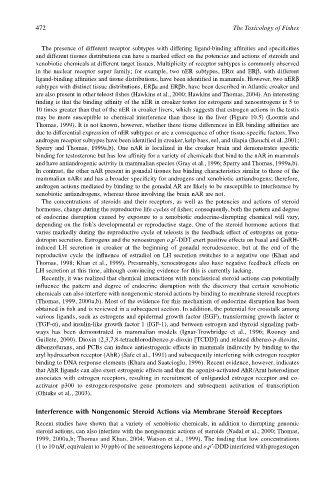Page 492 - The Toxicology of Fishes
P. 492
472 The Toxicology of Fishes
The presence of different receptor subtypes with differing ligand-binding affinities and specificities
and different tissues distributions can have a marked effect on the potencies and actions of steroids and
xenobiotic chemicals at different target tissues. Multiplicity of receptor subtypes is commonly observed
in the nuclear receptor super family; for example, two nER subtypes, ERα and ERβ, with different
ligand-binding affinities and tissue distributions, have been identified in mammals. However, two nERβ
subtypes with distinct tissue distributions, ERβa and ERβb, have been described in Atlantic croaker and
are also present in other teleost fishes (Hawkins et al., 2000; Hawkins and Thomas, 2004). An interesting
finding is that the binding affinity of the nER in croaker testes for estrogens and xenoestrogens is 5 to
10 times greater than that of the nER in croaker livers, which suggests that estrogen actions in the testis
may be more susceptible to chemical interference than those in the liver (Figure 10.5) (Loomis and
Thomas, 1999). It is not known, however, whether these tissue differences in ER binding affinities are
due to differential expression of nER subtypes or are a consequence of other tissue-specific factors. Two
androgen receptor subtypes have been identified in croaker, kelp bass, eel, and tilapia (Ikeuchi et al.,2001;
Sperry and Thomas, 1999a,b). One nAR is localized in the croaker brain and demonstrates specific
binding for testosterone but has low affinity for a variety of chemicals that bind to the nAR in mammals
and have antiandrogenic activity in mammalian species (Gray et al., 1996; Sperry and Thomas, 1999a,b).
In contrast, the other nAR present in gonadal tissues has binding characteristics similar to those of the
mammalian nARs and has a broader specificity for androgens and xenobiotic antiandrogens; therefore,
androgen actions mediated by binding to the gonadal AR are likely to be susceptible to interference by
xenobiotic antiandrogens, whereas those involving the brain nAR are not.
The concentrations of steroids and their receptors, as well as the potencies and actions of steroid
hormones, change during the reproductive life cycles of fishes; consequently, both the pattern and degree
of endocrine disruption caused by exposure to a xenobiotic endocrine-disrupting chemical will vary,
depending on the fish’s developmental or reproductive stage. One of the steroid hormone actions that
varies markedly during the reproductive cycle of teleosts is the feedback effect of estrogens on gona-
dotropin secretion. Estrogens and the xenoestrogen o,p′-DDT exert positive effects on basal and GnRH-
induced LH secretion in croaker at the beginning of gonadal recrudescence, but at the end of the
reproductive cycle the influence of estradiol on LH secretion switches to a negative one (Khan and
Thomas, 1998; Khan et al., 1999). Presumably, xenoestrogens also have negative feedback effects on
LH secretion at this time, although convincing evidence for this is currently lacking.
Recently, it was realized that chemical interactions with nonclassical steroid actions can potentially
influence the pattern and degree of endocrine disruption with the discovery that certain xenobiotic
chemicals can also interfere with nongenomic steroid actions by binding to membrane steroid receptors
(Thomas, 1999, 2000a,b). Most of the evidence for this mechanism of endocrine disruption has been
obtained in fish and is reviewed in a subsequent section. In addition, the potential for crosstalk among
various ligands, such as estrogens and epidermal growth factor (EGF), transforming growth factor α
(TGF-α), and insulin-like growth factor 1 (IGF-1), and between estrogen and thyroid signaling path-
ways has been demonstrated in mammalian models (Ignar-Trowbridge et al., 1996; Rooney and
Guillete, 2000). Dioxin (2,3,7,8-tetrachlorodibenzo-p-dioxin [TCDD]) and related dibenzo-p-dioxins,
dibenzofurans, and PCBs can induce antiestrogenic effects in mammals indirectly by binding to the
aryl hydrocarbon receptor (AhR) (Safe et al., 1991) and subsequently interfering with estrogen receptor
binding to DNA response elements (Khara and Saatcioglu, 1996). Recent evidence, however, indicates
that AhR ligands can also exert estrogenic effects and that the agonist-activated AhR/Arnt heterodimer
associates with estrogen receptors, resulting in recruitment of unliganded estrogen receptor and co-
activator p300 to estrogen-responsive gene promoters and subsequent activation of transcription
(Ohtake et al., 2003).
Interference with Nongenomic Steroid Actions via Membrane Steroid Receptors
Recent studies have shown that a variety of xenobiotic chemicals, in addition to disrupting genomic
steroid actions, can also interfere with the nongenomic actions of steroids (Nadal et al., 2000; Thomas,
1999, 2000a,b; Thomas and Khan, 2004; Watson et al., 1999). The finding that low concentrations
(1 to 10 nM, equivalent to 30 ppb) of the xenoestrogens kepone and o,p′-DDD interfered with progestogen

